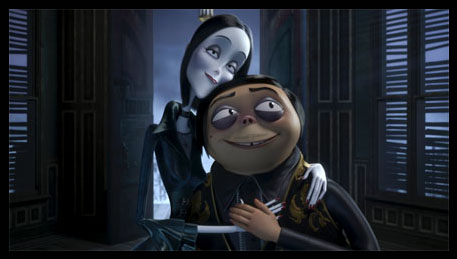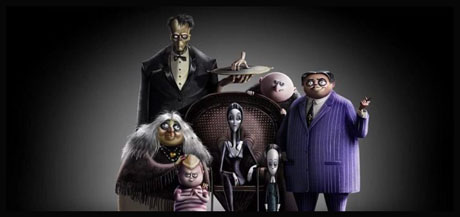
The Addams Family, created by cartoonist Charles (Chas) Addams, have been hovering around popular culture since 1938. Perhaps the most macabre nuclear family ever created, they were appropriate to their times. The Great Depression had not yet abated. Monstrous dictators were rearing their heads in Europe and Asia. It may be hard to believe today, but the famed Universal Monsters were causing audiences to faint in their seats. In a way, the Addams Family were more “universal”; they represented the darker side of family life, except with unabashed glee, reveling in their gruesome lifestyles.
The 2019 movie is not their first incarnation outside the pages of the New Yorker, where Addams’ one-panel cartoons ran for decades, but it is the most visually faithful to Chas’ visual style. Patriarch Gomez, his wife Morticia, children Pugsley and Wednesday, Uncle Fester and hulking butler Lurch faithfully follow Chas’ designs.

Most familiar to audiences is probably the 1964-1966 TV series. The 2019 movie borrows heavily from tropes and memes from the show, such as Gomez’ headstands, Morticia clipping the heads off roses, and Uncle Fester igniting a lightbulb in his mouth. Also borrowed is the disembodied hand known as “Thing”.
The voice actors portraying the Family do not stray far from their TV counterparts. Nick Kroll (Uncle Fester) is the most obvious example, aping Jackie Coogan expertly. Conrad Vernon (Lurch) does a fine imitation of Ted Cassidy. Oscar Isaac and Charlize Theron (Gomez and Morticia) sound very much like John Astin and Carolyn Jones. Finn Wolfhand as Pugsley, and Chloe Grace Moretz (who manages to be flippant and sullen with equal ease) are the exceptions.
The direction by longtime DreamWorks veteran Conrad Vernon and Nitrogen Studios founder Greg Tiernan works for the most part. After their collaboration on the 2016 adult-themed animated film Sausage Party, they seemed to be of a single mind on working with Chas’ bizarre characters, and lapses in characterization and continuity are very few.
Much more could have been done with these characters, but the story lets the film fall flat. Despite some clever lines and innuendos that Chas himself might have enjoyed, Matt Lieberman’s screenplay (he also worked on story along with Vernon and Erica Rivinoja) follows an all too-familiar path.

The Story: On their wedding night, Gomez and Morticia are forcibly exiled from their village. They relocate in an abandoned asylum in New Jersey, spawn two children, and live their warped lives undetected. Thirteen years pass, and it is time for Pugsley to attain manhood by completing the traditional saber mazurka (seen later in the film as a ghoulish take on a bar mitzvah). In the valley below, home improvement TV star Margaux Needler (Allison Janney, sporting the best coif in animation history) is developing a colorful planned community called “Assimilation” (undoubtedly a play on Disney World’s “Celebration”). Upon discovering the Addams home, she decides that it, and they, must go.
Meanwhile, Margaux’s daughter Parker (Elsie Fisher) befriends Wednesday and convinces her to attend public school. They become friends, declare that they want to decide who they really want to be, and begin taking on each other’s trappings, to the dismay of both Moms. As the extended family begins to descend on Assimilation for the mazurka ceremony, Wednesday and Parker openly rebel. Events lead Margaux to mobilize the citizens to destroy the Addams, finally wrecking their home. In the climactic battle, it is revealed that Margaux has been secretly spying on the town’s inhabitants, who turn on her and decide to accept the Addams despite their differences. The Addams and all their relatives come to live in the new, integrated Assimilation with Gomez and Morticia looking down lovingly from their restored asylum; a reformed Margaux pairs off with Uncle Fester, representing the new attitude of embracing differences.
Chart your own path, be your true self, celebrate differences, don’t let appearances deceive you. Conformity is bland and bad: a song and dance number by several of the community’s kids highlights this point. Have we been here before? Many times? Why is this message repeated to so many kids by so many recent animated films? How often does the theme of celebrating diversity and valuing self-esteem and self-determination need to be reinforced? Are today’s kids non-respondent and stupid, or do today’s filmmakers believe that to be the case?
The cruelest thing that the world inflicts on Wednesday and Parker is that they are denied by adults to express themselves differently. I thought about dragging every kid in the audience to a showing of Isao Takahata’s Grave of the Fireflies; there they could see an animated film about how heartless adults can truly be to children.
This could have been a much better film if the sardonic darkness of Chas’ original cartoons had been allowed full play; instead the film turns sweeter as it progresses. As I left the theater, a depressing thought came to me: I bought a ticket to see The Addams Family. The more I compared the plots and storylines, I realized that I had actually paid to see a remake of UglyDolls.
- ANIME REVIEW: “Lonely Castle in the Mirror” - September 24, 2023
- REVIEW: “Teenage Mutant Ninja Turtles: Mutant Mayhem - August 15, 2023
- REVIEW: “Spider-Man: Across The Spider-Verse” - June 7, 2023


 October 23rd, 2019
October 23rd, 2019  Martin Goodman
Martin Goodman  Posted in
Posted in  Tags:
Tags: 






